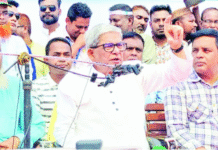
An international organisation has raised serious questions about the much-debated Rampal coal-fired power plant, saying it does not maintain the minimum social and environmental standards.
“The project poses significant adverse social and environmental risks and impacts that are diverse and irreversible,” said Bank Track, a Netherlands-based coalition of organisations “targeting the operations and investments of private sector banks and their effect on people and the planet”.
In a recent analysis, it said serious deficiencies in project design, planning, and implementation and due diligence obligations render the project non-compliant with the minimum social and environmental standards and the International Finance Corporation’s (IFC’s) performance standards.
However, the government as well as the Bangladesh-India Friendship Power Company Pvt Ltd (BIFPLC), which was formed to develop the Rampal project, claimed the 1,320MW plant would not harm the Sundarbans as international standards were being followed properly.
The Rampal plant is located just 14 kilometres upstream of the Sundarbans Reserve Forest, the world’s largest remaining contiguous mangrove forest and a UNESCO World Heritage Site.
India’s largest coal power company National Thermal Power Corporation (NTPC) has formed a joint venture, BIFPLC, with Bangladesh Power Development Board (BPDB) on 50:50 share basis to develop the plant.
A tender for the project’s Engineering, Procurement and Construction (EPC) contract has been released and the bidding is due in the second half of the year.
Green activists are concerned the plant would lead to its environmental degradation from increased ship traffic, dredging, and air and water pollution.
Coal-fired thermal power plants belch toxic gases that could impact wildlife and human health, and forest quality in the neighbourhood, leading the country’s many environmentalists to continue their call to scrap the plant.
FLAWS TOO MANY
Bank Track has based its analysis on the Equator Principles (EP), an environmental and social risk management framework for financial institutions, and found that the project fails to comply with six of the 10 principles of the EP.
The plant, which will be comprised of two 660MW supercritical units, is estimated to burn 4.72 million tonnes of imported coal each year.
The coal will be transported by a fleet of vessels travelling along a route that cuts directly through the Sundarbans for a distance of approximately 67 kilometres. It is estimated that 59 ships will make the voyage each year to meet the plant’s coal requirement. All ships will anchor at Akram Point — located within the Sundarbans — where massive loads of coal will be offloaded to smaller vessels, running the risk of coal spillage and toxic coal dust being released into the environment, Bank Track warned.
It also questioned the Environmental Impact Assessment (EIA), conducted by the Centre for Environment and Geographic Information Services (CEGIS), a public trust under the water resources ministry.
First released in January 2013, the assessment drew severe criticisms from environmentalists and civil society members for being blatantly biased in favour of the project and for failing to meet international standards.
The CEGIS subsequently modified the assessment and a revised EIA was published in July that year.
“However, there are many serious concerns that remain unaddressed in the revised EIA,” said the Bank Track analysis.
It said serious deficiencies include failure to carry out a separate EIA on the impacts of transporting coal through the Sundarbans; insufficient assessment of factors and risks relating to water consumption, transport and disposal of coal ash, and waste management; and weak assessment of impacts on existing livelihoods, in particular impacts on people who depend on the Pashur river and the fisheries and other resources within the Sundarbans.
The assessment process and documentation for the plant falls far short of these minimum requirements, said the analysis.
In direct violation of the IFC requirement to comply with the relevant laws of host countries, the Rampal project breaches Bangladesh’s Environmental Conservation Regulation 1997, the Environment Conservation Act 1995, and the Forest Act 1927, it said.
Besides, the outer perimeter of the ecologically critical area (ECA) around the Sundarbans is located just 4 kilometres from the plant, raising concerns about potential adverse impacts within the ECA itself, it went on.
Bank Track said there is no evidence that an Environmental and Social Management System (ESMS) or an Environmental and Social Management Plan (ESMP) has been prepared for the project.
The ESMS intends to identify and detail the country’s commitments to address and mitigate risks and adverse impacts identified during the environmental impact assessment process, while the ESMP addresses issues raised in the assessment process and incorporate actions required to ensure that the project is in compliance with all applicable standards.
Despite the increase in the volume of shipping traffic that the project will require, the EIA’s Environmental Management Plan does not address or include emergency plans and measures in the event of a shipping accident during coal transport, nor does it describe any existing or planned resources for containing or preventing the spread of toxic materials in such cases, said the analysis.
The failure to address the potential health hazard posed by dissemination of mercury, chromium, arsenic and other toxic heavy metals too bodes ill for the people in the region, it said.
Furthermore, the EIA does not propose or provide detailed measures for the mitigation and management of adverse social impacts, it added.
The analysis stated the Rampal project has failed to demonstrate effective stakeholder engagement and to provide evidence of an accessible, legitimate, and functioning grievance mechanism to address and resolve the concerns of people who have been harmed by the forcible acquisition of land and other resources that formerly sustained them.
ALL’S WELL IN THE GOVT’S EYES
Nasrul Hamid, state minister for power, energy and mineral resources, and Ujjwal Kanti Bhattacharya, managing director of the BIFPLC, said the criticisms of the plant are not based on ground realities.
“People who are opposed to the project don’t seem to know the details of it,” said the state minister.
Bhattacharya claimed the company is taking the most stringent environmental protection measures, which are in line with the IFC standards. The plant would not harm cultural heritage and biodiversity and living natural resources. The EIA has been done in line with the laws of the country.
Bhattacharya said the Indo-Bangla company’s cost has gone up to make arrangements to prevent emission of toxic gas from the plant.
“We have kept the limits of sulphur oxide (SOx) emission and noise pollution lower than the IFC-set benchmarks. We are spending a lot for environmental protection. There are no areas where we are not following the IFC standards,” he claimed.
In the EIA study, the maximum resultant concentration of SOx and nitrogen oxide (NOx) has been indicated at 53.4μg/Nm3 and 51.2μg/Nm3 respectively, whereas the ambient air quality standard of Bangladesh as per the Department of Environment for the two oxides is 80μg/Nm3, according the BIFPCL officials.
They say the above calculation was done without taking into account the flue gas desulphurisation (FGD) in the EIA study.
“Now with the installation of the FGD system and provision of low NOx burner, the concentration of SOx and NOx will get further reduced to comply with the stringent norms of the World Bank standards. Besides, all sorts of emissions would be monitored online,” the BIFPLC managing director said.
As for the EIA, he said a separate assessment study has been conducted by the Mongla Port Authority for capital dredging of the Pashur river.
“After capital dredging, coal will be transported through a national navigational route which is already being used by the Mongla Port Authority for decades,” he said, adding that a proper ash management system has been planned.
Bhattacharya said the BIFPLC would plant five lakh trees around the project area, starting with 30,000 trees this year and two lakh more in the next three to four years. Coals would be transported in covered barges and stored in covered areas. A 275-metre tall chimney would be set up to keep the smoke emission away from the Sundarbans.
“We are setting up a power plant which is environment-friendly. As far as environment is concerned, we are not making any compromises,” he asserted.
Environmentalists, however, are not convinced by the government’s claims.
Ainun Nishat, an internationally reputed environmentalist, said he does not think that a proper EIA has been carried out for the project.
“If the Environment Conservation Act 1995 had been followed, the picture would have been different,” he told The Daily Star.
Source: The Daily Star









